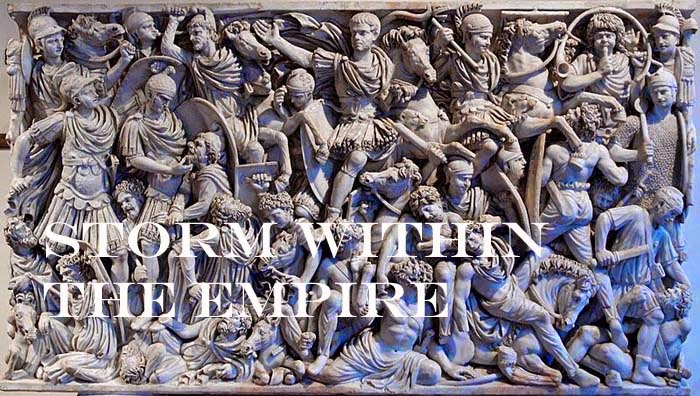Battle along the Loire River, 534.
Theudebert meets the Bavarians near Giessen, 534.
Childebert confronts a rebel army outside Paris, 544.
Chlothar leads the royal army to suppress a revolt,
544.
Battle
along the Loire River, 543 AD
During the summer of 534, Childebert and Chlothar marched
south to do battle with the Visigoths near Orleans. The Neustrian army deployed
on open ground between the Loire River and a nearby hamlet; the latter was defended
by the majority of tribal infantry with all the militia infantry covering the space
between hamlet and the Loire River. The Visigoths formed their troops into two divisions;
the infantry on the left would clear the village at which time the cavalry of
the right division would begin their attack. To the right of the Visigothic
cavalry skirmishers would use the marshy area to harass the Neustrian left.
The attack on the village proved successful and quick as
neither Frankish king could make an adequate response (low pip scores). In
desperation, Childebert counter attacked the Visigothic infantry holding the
village by taking troops from the battle line. Both sides were now experiencing
heavy casualties leaving undecided the question of who held the village (3 –
3).
Realising that he could lose this battle, the Visigothic
king launched the full weight of his mounted force on the Neustrian line
breaking through its centre. The casualties inflicted left Childebert no choice
but to call a retreat (3 – 4).
Theudebert
meets the Bavarians near Giessen,543 AD
Theudebert rallies the Thuringian nobles and confronts
the Bavarians encamped near the village of Giessen. The Bavarians were deployed
in deep columns with the intervals filled by smaller groups of tribal infantry.
Using the woods to protect his right flank, Theudebert positioned the Ripuarian
infantry to face the enemy centre and the Gallo-Roman militia and cavalry
extended the left flank.
The Franks were eager to avenge their Thuringian
cousins and the death of their king and attacked the Bavarians with such fury
driving their entire battle line back 120 paces. In that time, Theudebert gained
sufficient time to regroup his reserve cavalry to prepare for the expected
breakthrough.
On the left, the loss of a Frankish militia unit was
quickly filled by cavalry from the reserve line. These destroyed a Bavarian warband
giving the cavalry an opportunity to fall on the exposed flank of a deep
column. Its destruction and came quickly and with it the death of the Bavarian
king. This final action brought the battle to a close and a victory for
Theudebert (4g – 2).
Childebert
confronts a rebel army outside Paris, 544 AD
Following the defeats by the Saxons, Breton and the
Visigoths a great number of disaffected nobles rebelled against Childebert. Each
mustering 3,000 troops the armies met on suitable ground a day’s march outside
of Paris.
The action was brisk with the militia on both sides holding
well against each other. Only the tribal infantry on each side exhibited more
vigour for the fight and the Neustrian with greater numbers pushed back the rebel
infantry, unfortunately they found themselves beyond their own support. From this
exposed position the mounted rebel nobles struck the open flank of the
Neustrian warband. The resulting casualties were enough to send Childebert in
full retreat back to Paris (2 – 1).
Chlothar leads the royal army to suppress a revolt, 544 AD
News of Childebert’s defeat emboldened the rebellious
nobles of Reims to face Chlothar in open battle. This took place near the River Aisne
with the royal army, led by Chlothar in person, deployed for battle along the crest of
hill. The position was too strong to assault and so the rebels crossed the
Aisne to seize the hill flanking the position of the royal army.
This forced Chlothar to try and head them off lest
the rebels redeploy on favourable ground. The next few minutes were spent
trying to reach the hill as quickly as possible. The troops of the royal army were hindered by having to change
from line to column and attempt the crossing of the Aisne in rapid tempo. Having sent the bulk of
its infantry ahead to secure the hill, the rebels were able to reach the
hill first.
Showing contempt for the rebel troops, Chlothar pushed his troops across leaving half his force on the opposite bank. This presented the rebels with a golden opportunity and quickly launched their battle line to catch the royal troops as they collected on the near bank of the Aisne. Chlothar’s troops
were cut down leaving him no further option but to call a retreat and taking
flight back to Reims (2 – 0).
Notes:
The card system worked well to cover the events as they unfolded during a full turn of ten years. Only one card is drawn for
each realm as the same card can be used for changing situations, such as moving from a positive to a negative event. Case in point, Childebert (Neustria) had experienced a number of
setbacks lowering his standing to a negative level placing Childebert in the unenviable position of confronting dissident nobles within his realm. Naturally when writing about these events they do need time to reach a boiling point; this may require a season or a full year depending on the circumstances. History does provide enough examples to serve as a guideline.
Internal conflicts or civil wars were handled in a simple manner; the armies involved for such conflicts used the standard DBA army list and evenly divided the troop
types between the two combatants. Six elements is the smallest any command may be if using the big battle option and this worked well to help speed the flow
of the campaign. These small actions often provide greater challenges as the victory conditions are lowered.To date, this now makes nineteen battles fought since the start of the campaign.












This comment has been removed by a blog administrator.
ReplyDelete